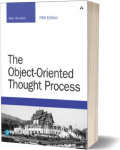The Object-Oriented Thought Process, 5th Edition
Software Development
Book Details
Book Title
The Object-Oriented Thought Process, 5th Edition
Author
Matt Weisfeld
Publisher
Addison-Wesley Professional
Publication Date
2019
ISBN
9780135182130
Number of Pages
475
Language
English
Format
File Size
5.6MB
Subject
object-oriented-programming
Table of Contents
- Cover Page
- About This E-Book
- Half Title Page
- Title Page
- Copyright Page
- Dedication Page
- Contents at a Glance
- Table of Contents
- Acknowledgments
- About the Author
- We Want to Hear from You!
- Reader Services
- Figure Credits
- Introduction
- This Book’s Scope
- What’s New in the Fifth Edition
- The Intended Audience
- The Book’s Approach
- Source Code Used in This Book
- 1. Introduction to Object-Oriented Concepts
- The Fundamental Concepts
- Objects and Legacy Systems
- Procedural Versus OO Programming
- Moving from Procedural to Object-Oriented Development
- What Exactly Is an Object?
- What Exactly Is a Class?
- Using Class Diagrams as a Visual Tool
- Encapsulation and Data Hiding
- Inheritance
- Polymorphism
- Composition
- Conclusion
- 2. How to Think in Terms of Objects
- Knowing the Difference Between the Interface and the Implementation
- Using Abstract Thinking When Designing Interfaces
- Providing the Absolute Minimal User Interface Possible
- Conclusion
- References
- 3. More Object-Oriented Concepts
- Constructors
- Error Handling
- The Importance of Scope
- Operator Overloading
- Multiple Inheritance
- Object Operations
- Conclusion
- References
- 4. The Anatomy of a Class
- The Name of the Class
- Comments
- Attributes
- Constructors
- Accessors
- Public Interface Methods
- Private Implementation Methods
- Conclusion
- References
- 5. Class Design Guidelines
- Modeling Real-World Systems
- Identifying the Public Interfaces
- Designing Robust Constructors (and Perhaps Destructors)
- Designing Error Handling into a Class
- Designing with Reuse in Mind
- Designing with Extensibility in Mind
- Designing with Maintainability in Mind
- Using Object Persistence
- Conclusion
- References
- 6. Designing with Objects
- Design Guidelines
- Object Wrappers
- Conclusion
- References
- 7. Mastering Inheritance and Composition
- Reusing Objects
- Inheritance
- Composition
- Why Encapsulation Is Fundamental to OO
- Conclusion
- References
- 8. Frameworks and Reuse: Designing with Interfaces and Abstract Classes
- Code: To Reuse or Not to Reuse?
- What Is a Framework?
- What Is a Contract?
- An E-Business Example
- Conclusion
- References
- 9. Building Objects and Object-Oriented Design
- Composition Relationships
- Building in Phases
- Types of Composition
- Avoiding Dependencies
- Cardinality
- Tying It All Together: An Example
- Conclusion
- References
- 10. Design Patterns
- Why Design Patterns?
- Smalltalk’s Model/View/Controller
- Types of Design Patterns
- Antipatterns
- Conclusion
- References
- 11. Avoiding Dependencies and Highly Coupled Classes
- Composition versus Inheritance and Dependency Injection
- Conclusion
- References
- 12. The SOLID Principles of Object-Oriented Design
- The SOLID Principles of Object-Oriented Design
- Conclusion
- References
- Index
- Code Snippets
